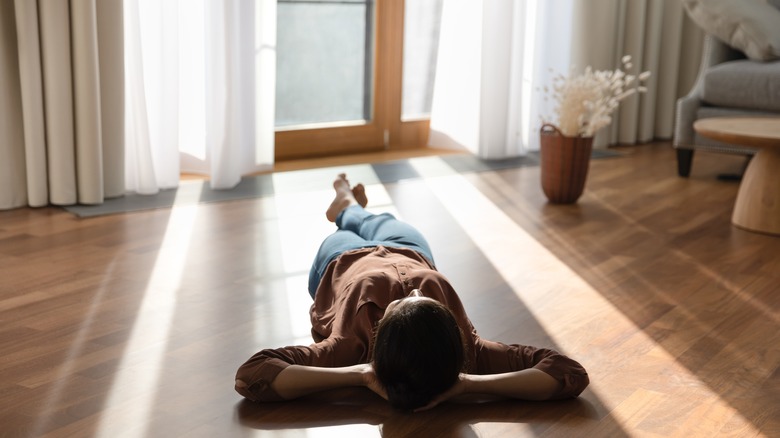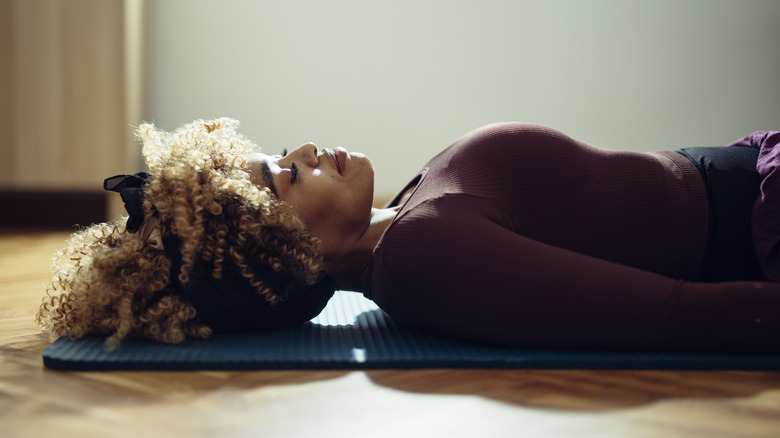Floor Time: The Viral Stress-Relief Practice, Explained By Our Life Coach
Sometimes, flopping down on your living room floor like a starfish is the only thing that keeps you sane at the end of a long day. Perhaps that sounds silly, but for some people, this is a regular habit that helps them decompress and reset after the workday. The urge to lay on the ground with your limbs splayed out — or an arm tossed over your eyes in the universal gesture for "I'm so done" — has been aptly named "floor time" on TikTok and currently sits at over 65 million views. For the floor time club, resting on the ground communicates a need to wind down following the daily stresses of life.
According to Mason Farmani, a Florida-based intuitive personal and corporate life coach, this practice allows people to process the day's events and manage their emotions. "People use floor time when they are feeling overwhelmed, sad, or after a breakup, as well as to unwind after a long day," Farmani explains to Glam during an exclusive interview. TikTok clips similar to @siamuh's video, which boasts three million views, have become popular as they resonate with folks who routinely partake in floor time and may not understand the underlying reason behind the behavior. Farmani shares that many people rely on this practice "to cope with various emotions and situations," and indulging in a bit of floor time now and then provides a healthy boost to your mental and physical health.
How does floor time support mental health?
Lying on the floor offers surprising health benefits — the most obvious being stress reduction. "The physical act of lying down can trigger the body's relaxation response, promoting feelings of calmness, groundedness and reducing stress levels," intuitive life coach Mason Farmani explains to Glam during an exclusive chat. Floor time doubles as a form of mindfulness by keeping you grounded, encouraging you to self-regulate, and helping your body relieve any physical tension from earlier in the day. "It allows individuals to take a break from the demands of daily life and create space for processing and regulating their emotions in a safe and supportive environment," Farmani adds.
That said, finding the time to rest on the ground uninterrupted isn't always feasible. In this case, Farmani recommends supplementing your floor time with alternative practices and hobbies to support your mental health. This includes forming an awareness of your stress levels throughout the day and practicing deep-breathing techniques, such as box breathing, for stress relief. "Additionally, taking mini-meditation breaks throughout the day can help reset the mind by giving your thoughts a break and reduce stress levels, even with just a few minutes of focused attention on the breath or body sensations." To alleviate physical stress, Farmani also recommends Progressive Muscle Relaxation (PMR) — a technique where you consciously tense and then relax your muscles — and mindful walking in nature.
How to reap the benefits of floor time
If you are new to the floor time crew and keen to give it a go, Mason Farmani provides several tips to help you make the most of your floor time practice. First, refrain from using electronics, such as your phone or TV, as they distract you from fully immersing yourself in the moment. Similarly, choose a quiet and comfortable space to lie down to minimize other distractions and interruptions. "Consider using a yoga mat or a soft blanket to cushion the floor and make your experience more enjoyable," Farmani tells Glam exclusively. "If you have back issues, raise your knees."
Once you set up an ideal environment, ground yourself and turn inward by paying attention to your breathing. "[Breathe] in to the slow count of four, hold for two, out for six, hold for two, and repeat 10 times," Farmani recommends. He also suggests setting an intention for your floor time practice. "Whether it's to relax, release stress, or take a break, having a clear intention can guide your experience and enhance its effectiveness."
While there's no time limit to floor time, the longer you remain grounded and present, the better. The best part is that no one can blame you for counting it toward your daily hatha yoga sesh, so go ahead and tick that off your checklist by citing a full 15 minutes of Savasana ("corpse pose").


